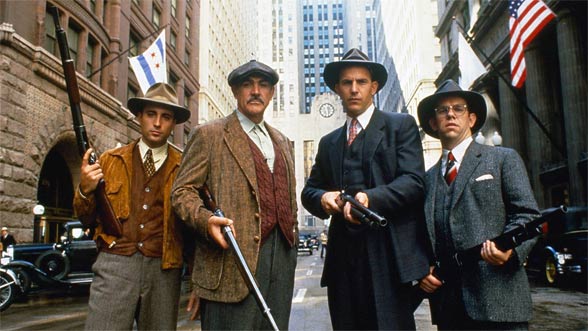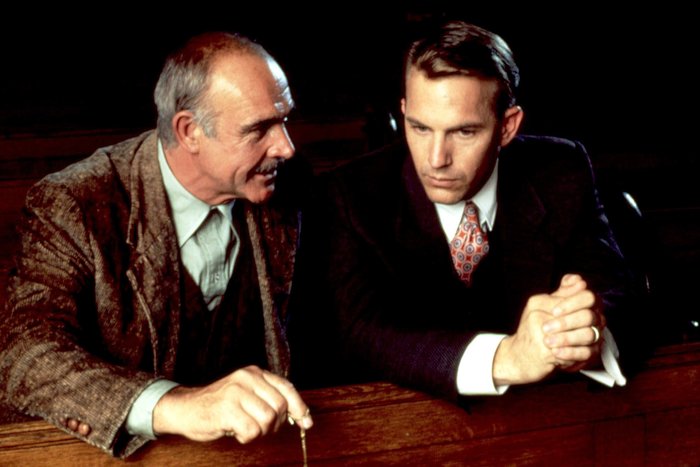The Untouchables (1987)
CAST: Kevin Costner, Sean Connery, Robert De Niro, Andy Garcia, Charles Martin Smith, Patricia Clarkson, Billy Drago
REVIEW:
Brian De Palma’s magnum opus The Untouchables (loosely inspired by the television series, which in turn was loosely based on historical fact) freely takes sizable liberties with the true story it loosely tells and is an unabashedly Hollywoodized saga of the 1930s clash between Treasury officers led by Eliot Ness and Prohibition-era Chicago crime lord Al Capone, but this is a case of the filmmakers not letting the facts get in the way of a good story. The Untouchables doesn’t pretend to be a docudrama, instead a rousing adventure that serves up a plucky band of underdog good guys versus the seemingly all-powerful big bad. It’s easy to get swept up in that kind of David vs. Goliath story, and The Untouchables succeeds on virtually every level, serving up colorful hissable villains, juicy dialogue, a fast-moving pace, some memorable action sequences, moments of humor and tragedy, and a crowd-pleasing triumph of good over evil.
In 1930 Chicago, crusading, straitlaced Treasury officer Eliot Ness (Kevin Costner) comes to town as a man on a mission to staunchly enforce the nation’s Prohibition laws and setting his sights on the most powerful crime boss of all, Al Capone (Robert De Niro) as Public Enemy No. 1. But when his early efforts prove embarrassingly ineffectual, Ness turns to more streetwise veteran beat cop Jimmy Malone (Sean Connery) for help, and together they recruit sharpshooter George Stone (Andy Garcia) and bookish accountant Oscar Wallace (Charles Martin Smith) into what becomes known as The Untouchables. But crossing Capone brings down a world of trouble, and victory won’t come easy or free.
The Untouchables might be considered a “gangster epic”, but it’s an entirely different vein from The Godfather. Unlike The Godfather, The Untouchables isn’t interested in humanizing the gangsters into three-dimensional, multifaceted life. The gangsters on-hand are caricaturish, with Capone himself and his chief assassin (Billy Drago) almost cartoonishly evil. The Untouchables deals unabashedly in black-and-white rather than complex shades of gray. It’s also a far less thematically rich film than The Godfather, but that’s not its aim. The Untouchables isn’t aiming for a deep, complex character study, but a rousing crowd-pleasing cinematic adventure, and to that end it is eminently successful. It’s a gangbusters (pun intended) crime adventure flick, with several tremendous action sequences, most prominently the raid at the Canadian border—given an old-fashioned Western vibe with the heroes charging in on horseback—and the climactic iconic train station shootout, which borrows a page from the Odessa Steps sequence from Sergei Eisenstein’s Battleship Potemkin, which slowly ratchets up the tension to Hitchcockian levels. The film received deserved Oscar nominations for production design and costumes, with an admittedly romanticized 1930s Chicago (displayed most fully in a wide-panning shot of La Salle Street, lined on both sides with dozens of period automobiles and populated with crowds of costumed extras), and stylish visuals. Capone’s scenes—which are few and far between—are filmed in rich, lush, glamorous colors, with an emphasis on red (for obvious thematic reasons), while scenes in Ness’ home life are simple and spartan, with muted hues. In the infamous scene in which Capone bludgeons a minion to death with a baseball bat, the effect of red blood splattered on white tablecloth is both gruesome and visually striking. The screenplay by David Mamet serves up plenty of juicy dialogue. Unsurprisingly, Sean Connery gets the best bits, including this hard-boiled monologue: “They pull a knife, you pull a gun. They send one of yours to the hospital, you send one of theirs to the morgue. That‘s the Chicago way!”. The movie might be unabashedly Hollywoodized and crowd-pleasing, but it doesn’t shy away from the world of danger Ness and company are stepping into. There’s plenty of violence that doesn’t skimp on the blood, and there’s moments of tragedy when not all of the so-called “Untouchables” come through unscathed (there’s also a jarring opening bit that flies in the face of audience expectations about most movies not daring to dispatch a young child).
On the acting front, Kevin Costner has the lead, but one could argue he’s the least memorable character. Part of it might be that Ness has been whitewashed of any unsavory aspects into a morally stalwart paradigm of “untouchable” virtue that’s more influenced by the posthumously inflated pop culture depictions of Ness than the man himself, but while he’s not bad in the role, Costner doesn’t really add much to the proceedings and his glum blandness is even more so compared to some of his colorful co-stars, like Sean Connery at his very most “Sean Connery” and Robert De Niro’s scenery-munching. Connery’s portrayal of Malone is hands down the best thing about The Untouchables, at least in terms of acting, and in fact is some of the most rounded and dimensional acting Connery has ever done. He gets plenty of deliciously streetwise one-liners and dry wit, but also an underlying poignancy that imbues Malone with more depth than just a standard-issue Connery mentor. The other Untouchables, Andy Garcia’s taciturn sharpshooter George Stone and low-profile character actor Charles Martin Smith’s bookish Oscar Wallace, stay more in the background, but each get their moment, when mousy accountant Wallace picks up a gun in the Canadian border ambush, and when Stone shows his prowess in the climactic train station shootout. In keeping with the movie’s black-and-white tone, Robert De Niro goes all-out playing Capone as an over-the-top, larger-than-life, cartoonish villain who’d be at home squaring off with Dick Tracy or Batman. He swaggers around in flamboyant wardrobes, he rants and raves (“I want him dead, I want his family dead, I want his house burned to the ground!”), and in a memorably brutal scene, bashes one of his own underlings’ heads in with a baseball bat (actually, this is one of the movie’s more historically accurate moments). There’s no subtlety or nuance here (nor is any intended) and there’s nothing three-dimensional about his portrayal, but it fits in with what De Palma is going for. De Niro’s role is basically a glorified cameo, with few and far between scattered appearances, but he’s probably used in just about the right amount; his scenery-chewing gusto is entertaining, but too much of it might have started to get old. Maybe even more bad-to-the-bone is Billy Drago as his chief hitman, who’s lip-smackingly loathsome enough to make us cheer when he gets his comeuppance. This is a man’s movie; apart from Patricia Clarkson in a small token role as Ness’ blandly supportive wife, there’s nary a woman to be found beyond extras.
The Untouchables plays fast and loose with the true story it takes as inspiration. While it broadly follows the basic gist of the historical record, the characters not named Ness or Capone are mostly composites or fictional, and several of the most memorable scenes, including the train station shootout, are inventions (also for those wondering, no Eliot Ness did not throw Frank Nitti off a roof). But while The Untouchables might irritate sticklers for historical accuracy, it’s hard to argue with the narrative choices onscreen in and of themselves because, as far as the stand-alone movie goes, they work. It’s easy to get swept up in the charge on horseback, or be brought to the edge of our seats in the train station. Put simply, The Untouchables is a grand, larger-than-life adventure tale brought colorfully to the screen, and the crown jewel of Brian De Palma’s filmmaking career. It might not be a “perfect” motion picture, but it deserves the label of “classic”.
* * * 1/2

